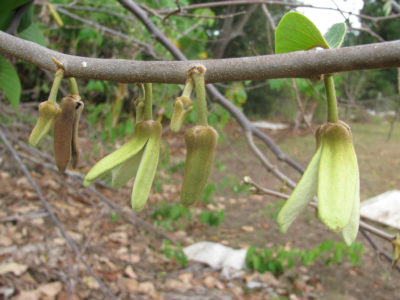
Cherimoya fruit - Photo by Forest and Kim Starr
Cherimoya originates from the Andes area in South America. It is a small tree which is grown for its sweet fruits. The fruits are sometimes known as “custard apple” but that name is also used for several different (but related) fruit species.
Names
Scientific
Annona cherimola
English
Cherimoya
Chirimoyo
Chirimuya
Custard apple
Momona
Dutch
Cherimoya
Jamaica-appel
Spanish
Chirimoya
Chirimoyo
French
Chérimole
Chérimolier
German
Cherimoya
Chirimoya
Churimoya
Taxonomy
Order
Magnoliales
Family
Annonaceae
Genus
Annona
Species
Annona cherimola (Cherimoya)
Basic information and facts
Origin:
Andes region in South America (Ecuador, Colombia, Peru)
Distribution:
Andes regions, Argentina, Mexico, California, South of Spain, Italy and Portugal.
Evergreen or deciduous:
Cherimoya is an evergreen fruit tree.
Fruits:
The fruits are oval, usually 10 to 20 cm long and about 7 to 10 cm in diameter. Fruits are smooth or have a slightly tuberculated skin surface. The sweet flesh is white and contains several dark brown seeds.
Climate and weather:
Cherimoya grows in subtropical climate. It can survive in mild temperate climates.
Pollination:
If natural pollinators are not available, hand pollination of flowers is necessary.
Height:
Grows as a shrub or trees which can get about 7 to 9 meter tall.
Spacing:
Propagation:
Grafting on seedlings.
Insect pests:
Mealybugs and snails can cause damage.
Harvesting:
Pick fruits when they are still firm and then allow them to soften at room temperature.
Uses:
Fruits are eaten fresh.
Crop categories
Fruits
Minor crops
Subtropical crops
Temperate crops
Pictures

Cherimoya leaves - Photo by Forest and Kim Starr

Cherimoya fruit - Photo by Forest and Kim Starr

Cherimoya - Photo by Forest and Kim Starr

Cherimoya flowers - Photo by Forest and Kim Starr
